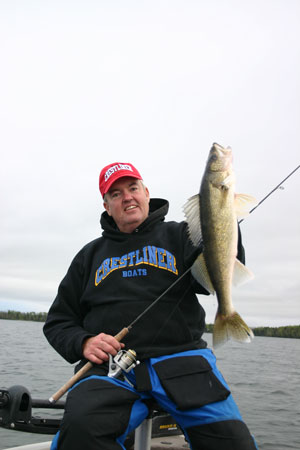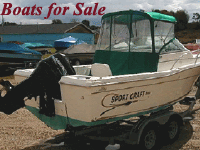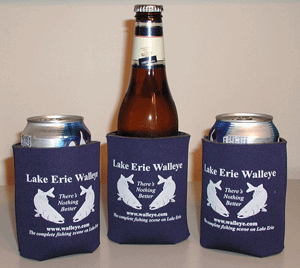Sooner or later there comes a time when you just need to slow down,
 drop
the hook, and get fishing. Instead of running here and running
there the quickest way to put fish in the boat may be camping on a spot.
Under the right conditions anchoring up and carefully straining an area
can pay big dividends and is method thatís often overlooked and
underused. Good walleye anglers know that being versatile is the key to
consistent catches and to be consistent you have to be adept at
employing a variety of techniques, including anchoring.
drop
the hook, and get fishing. Instead of running here and running
there the quickest way to put fish in the boat may be camping on a spot.
Under the right conditions anchoring up and carefully straining an area
can pay big dividends and is method thatís often overlooked and
underused. Good walleye anglers know that being versatile is the key to
consistent catches and to be consistent you have to be adept at
employing a variety of techniques, including anchoring.
One of the keys to successful anchoring is knowing just when and
where to employ the technique. For example; if youíre anchoring when you
should be rigging or trolling it will probably cost you some fish in the
long run. On the other hand if youíre rigging or trolling when you
should have dropped the hook the same result holds true.
Knowing when not to anchor may be as important as when you should.
For example; walleyes that are spread out along a slow tapering flat or
break would probably be better approached with a trolling or rigging
technique. Flat areas donít generally lend themselves well to anchoring
because walleyes tend to spread out and anchoring is so slow that you
canít get your bait in front of enough fish. The exception would be when
youíve located a tight school of fish on a flat or slow break that
arenít responding to other presentations. In that case it may be time to
throw a marker and drop the hook.
Another case for leaving the anchor in the boat is just about anytime
youíre looking for fish, although not always. Finding fish can be done
more quickly with a crankbait trolled through potential hideouts, for
example. However, if theyíre just not charged up enough to chase down a
bait you may have to tough it out and get busy with the anchor and hop
from spot to spot, and slowly work the most likely areas.
Anchoring can save the day when youíve located fish, even if mother
nature does her level best to blow you off the spot, and off your game.
Instead of saying uncle you may be able to stay on the fish and continue
to put them in the boat, even under some of the worst conditions.
The ď worst conditions ď can be characterized by heavy winds and
monster waves in the three to four foot category that can send you
running for cover. Anchoring under tough conditions like these call for
specialized techniques, and for some serious equipment.
In order to stay put when you need to you better have an anchor that
can get the job done. There is nothing more frustrating than being on
fish and not being able to hold. If youíre not prepared you may have to
pick up and head for calmer conditions, knowing all the while that you
just left the most productive area.
Year in and year out thereís been a couple of anchors that
consistently get the job done, and thatís a twenty-eight pound navy
style anchor and the Water Spike, which is a fluke type anchor. The navy
style anchor will hold todayís larger walleye boats, like my eighteen
and a half foot Crestliner Fish Hawk, and do so under some of the worst
possible conditions. A twenty-eight pound anchor gets to be a lot to
handle and takes a little work to put it out and drag it back in again,
but is an absolute must for staying put. The navy style anchor will hold
in a variety of bottom content including sand, gravel, mud, and rocks.
Where it runs into trouble is when the rocks are so large that the
cracks and crevasses created are such that they gobble up an anchor,
never to be seen again. Conditions like this call for a specialized
anchor and is where the fluke or blade style anchors really shine. The
Water Spike is designed to hold in good sized rocks and has a unique
shank that allows you to back it out if it becomes lodged. If it has a
down side itís the fact that it doesnít hold well in any thing but
rocks.
To be able to anchor successfully under a variety of conditions, you
might consider having both types on board. But rather than carrying two
anchors and two ropes, try attaching a navy style to one end, and a
Spike to the other.
Anchoring under the most severe conditions calls for a rope of a
hundred and fifty feet in length or more. To get the right angle on an
anchor so that it will grab and hold you may have to let out most of
that long rope. A good 5/8 inch rope is the way to go and is a lot
easier on the hands than the thinner, cheaper stuff. The rope is an
important part of the whole program, and no place to save a few bucks.
Rather than attaching directly to the anchor, a six or eight foot
piece of chain between the anchor and the rope will keep sharp rock
edges from wearing it down, and potentially breaking it off.
Another anchoring aid is a stretchy section which is short piece of rope
with a shock absorbing rubber center. That extra stretchy section will
help to cushion the blow when you get nailed by a really big wave and
keep your anchor in place.
Another necessity is bow cleats that are in the right place, and that
can handle the big rope. It wonít take long to find out where you want
them, but you could start with a pair on both sides of the bow a couple
of feet back, and another pair about four feet back. By simply changing
bow cleat position you can drastically change the position of the boat,
which is a big advantage when youíre trying to work an area over without
re-anchoring.
Although anchoring is a relatively slow and thorough technique, it
doesnít mean you should drop the hook and put up your feet. Instead, you
may be better off anchoring up, working an area over, and then picking
up and moving only to start the whole process over again. It can be a
little work, but it may be the big ticket to the mother load.






 drop
the hook, and get fishing. Instead of running here and running
there the quickest way to put fish in the boat may be camping on a spot.
Under the right conditions anchoring up and carefully straining an area
can pay big dividends and is method thatís often overlooked and
underused. Good walleye anglers know that being versatile is the key to
consistent catches and to be consistent you have to be adept at
employing a variety of techniques, including anchoring.
drop
the hook, and get fishing. Instead of running here and running
there the quickest way to put fish in the boat may be camping on a spot.
Under the right conditions anchoring up and carefully straining an area
can pay big dividends and is method thatís often overlooked and
underused. Good walleye anglers know that being versatile is the key to
consistent catches and to be consistent you have to be adept at
employing a variety of techniques, including anchoring.